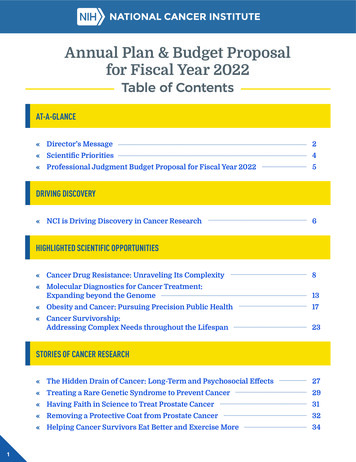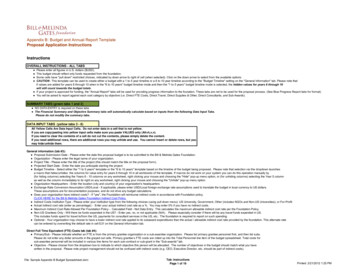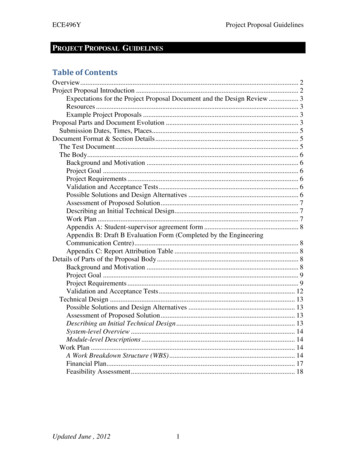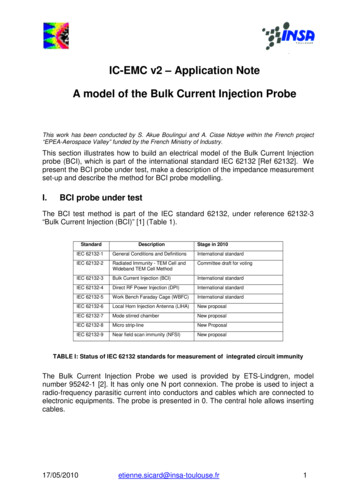
Transcription
Annual Plan & Budget Proposalfor Fiscal Year 2022Table of ContentsAT-A-GLANCE« Director’s Message2« Scientific Priorities4« Professional Judgment Budget Proposal for Fiscal Year 20225DRIVING DISCOVERY« NCI is Driving Discovery in Cancer Research6HIGHLIGHTED SCIENTIFIC OPPORTUNITIES« Cancer Drug Resistance: Unraveling Its Complexity8« Molecular Diagnostics for Cancer Treatment:Expanding beyond the Genome13« Obesity and Cancer: Pursuing Precision Public Health17« Cancer Survivorship:Addressing Complex Needs throughout the Lifespan23STORIES OF CANCER RESEARCH1« The Hidden Drain of Cancer: Long-Term and Psychosocial Effects27« Treating a Rare Genetic Syndrome to Prevent Cancer29« Having Faith in Science to Treat Prostate Cancer31« Removing a Protective Coat from Prostate Cancer32« Helping Cancer Survivors Eat Better and Exercise More34
Annual Plan & Budget Proposalfor Fiscal Year 2022At a GlanceDIRECTOR’S MESSAGE: MAINTAINING OUR FOCUS ON THE FUTUREDecades of sustained investment in biomedicalresearch have led to tremendous progressagainst cancer. This long-term commitmenthas driven our understanding of the biology ofcancer and uncovered new approaches to prevention,screening, diagnosis, and treatment of cancer.Many of these discoveries have directly benefitedbiomedical fields well beyond cancer.These strides were made possible by continuedsupport from Congress, the dedication of scientists,the commitment of the cancer research advocacycommunity, and—most importantly—the involvementof patients, survivors, and their loved ones.We now know that cancer is not one, but thousandsof different diseases. And yet, as much as we havelearned, important gaps remain in our understandingof cancer.2Norman E. Sharpless, M.D., NCI Directorsuggest that these factors could result in thousands ofadditional cancer deaths in the years ahead.NCI’s long history and expertise in navigatinguncertainty and tackling the seeminglyinsurmountable leave us well positioned to confronttoday’s—and tomorrow’s—challenges. WhileU.S. Department of Health & Human Services National Institutes of Health»I have personally witnessed the physical, emotional,and financial toll exacted by cancer. That toll hasbeen compounded by the COVID-19 pandemic, inpart because people with cancer may be at increasedrisk for complications from COVID-19. In addition,interruptions in health care services and concernsabout exposure to the virus have led to delayed cancerscreenings, diagnoses, and treatment. Early analysesTOP
contributing our scientific expertise to the current public health crisis, we remain focused on our top priority: cancerresearch. We have taken steps to ensure that the cancer research engine continues operating—not simply to maintainthe status quo, but to accelerate progress for the future.Recent events have focused the world’s eyes on the continuing racial injustice in America. Inequity persists incancer as well, as certain groups still face an increased risk of developing or dying from particular cancers. NCI hasa long record of supporting research to better understand and overcome these cancer health disparities, and we arecommitted to continuing this crucial work.We also must do more to increase diversity in the cancer research workforce to ensure that it reflects the diversecommunities we serve. The perspectives and talents of populations underrepresented in the sciences are vitallyimportant to the future growth of all areas of cancer research and care.In recent years, NCI has seen a dramatic increase in new investigators entering the cancer field, as evidenced by anearly 50% increase in grant applications submitted to NCI. Sustained budget increases across the cancer researchcontinuum are critical to continue fueling excitement in the field and funding highly meritorious research proposals.It is NCI-funded investigator-initiated basic research that has served as the source of the most innovative andtransformative work in cancer research, including work that has culminated in several Nobel Prizes in the lasttwo decades.As we approach the 50-year anniversary of the signing of the National Cancer Act of 1971, I’m reminded that theimprovements we’ve seen in cancer care have been thanks to investments in basic science. Progress has been fueledby patients who have pushed for cures and scientists who have refused to give up. We cannot afford to turn awayfrom promising research opportunities today, such as those laid out in this Annual Plan & Budget Proposal. With thenation’s support, nothing will stop us from advancing our understanding of cancer and reducing its burden—not justfor some, but for all people.Norman E. Sharpless, M.D.DirectorNational Cancer InstituteKEY MESSAGES To pursue the immense opportunities across the cancer research continuum, investments are needed across amultitude of funding mechanisms. Capitalizing on these future opportunities will lessen the adverse effects ofthe COVID-19 pandemic on patients diagnosed with cancer. Strong congressional support led to a nearly 20% increase in NCI’s budget from fiscal year (FY) 2013 to FY 2019.During this time, a dramatic increase in new investigators entered the cancer field resulting in a 50% increase inR01 grant applications submitted to NCI. Continued infusion of funding into research project grants is necessaryto capitalize on today’s scientific opportunities. The FY 2022 budget proposal will give NCI the ability to support grant commitments and further improve thepayline for R01 grants from the 10th to the 12th percentile. Doing so would allow NCI to fund a greater number ofmeritorious applications and make progress toward achieving the 15th percentile R01 payline by FY 2025.3» With steady and sustained budget increases supporting a cadre of talented researchers, NCI will be able tosupport promising research opportunities that improve our understanding of cancer and reduce the burden ofthe disease.TOP
SCIENTIFIC PRIORITIESNCI’S COVID-19 RESPONSENCI drives advances in cancer by investing in a broad portfolio ofresearch, from basic science to survivorship. In addition to investmentsin long-established areas of research, NCI pursues new and emergingscientific opportunities. The following areas represent just a few of themany areas that, with further investment, will catalyze progress incancer research.CONTINUITY FOR PATIENTSAND RESEARCHERSCANCER DRUG RESISTANCEDrug resistance remains one of the biggest challenges in cancer therapy.Cancers often have multiple mechanisms for surviving and growing,which may differ from patient to patient, and even from tumor to tumor.Catalyzing research aimed at solving the puzzle of why cancers becomeresistant to treatment will enable development of new strategies toovercome or prevent drug resistance in patients.Although the COVID-19 pandemic hasgreatly disrupted daily life, NCI’s toppriority is, and always will be, to advancecancer research and reduce the burdenof cancer. NCI is taking steps to meet theneeds of people with cancer and to keepthe nation’s cancer research enterpriseoperating with as few disruptionsas possible.PRIORITIES FOR PEOPLE WITH CANCER Providing clear information aboutcancer and COVID-19 Limiting disruptions to ongoing cancerclinical trials Providing care to trial participantswhile minimizing their risk of exposureMOLECULAR DIAGNOSTICS FOR CANCER TREATMENTPrecision medicine in cancer using genomic information about a patient’stumor has revolutionized cancer diagnosis and treatment. Progress willcontinue as genomic and proteomic information are integrated, as doingso will provide a clearer picture of a patient’s cancer and help informcancer treatment.OBESITY & CANCERNearly 40% of adults and 20% of children are obese, and those percentagesare increasing. Not only is obesity associated with a higher risk of 13types of cancer, it can also adversely affect cancer treatment and survival.Research to untangle the relationship between obesity and cancer willinform the development of effective strategies that prevent obesity andpromote weight loss to reduce cancer risk and improve patient outcomes.CANCER SURVIVORSHIPThe number of cancer survivors in the United States has growndramatically over the past several decades, with more than 22.2 millionestimated by 2030. More research is essential for developing effectiveinterventions that mitigate the many short- and long-term adverse effectsof cancer and its treatment. These interventions will improve thewell-being and quality of life of cancer survivors.PRIORITIES FOR CANCER RESEARCHERS Supporting grantees whose work hasbeen disrupted by the pandemic Extending funding applicationdeadlines Quickly funding research on COVID-19and cancerCONTRIBUTIONS TO COVID-19RESEARCHNCI has unique resources and expertiseto respond to the COVID-19 pandemic,including advanced technologies atthe NCI-sponsored Frederick NationalLaboratory for Cancer Research anddecades of support for research on theimmune system and cancer and cancerassociated viruses. NCI has mobilized itsnationwide research infrastructure to: Conduct studies of patients with cancerand COVID-19 Develop and evaluate SARS-CoV-2antibody tests and support research onserological sciences Search for and test compounds to treatpatients with COVID-19NCI has tremendous expertise andunique research capabilities that makeour participation in the response to thispandemic a moral obligation.”4»—NCI Director Dr. Norman E. SharplessTOP
PROFESSIONAL JUDGMENT BUDGET PROPOSAL FOR FISCAL YEAR 2022(dollars in millions) 6,245TOTALBUDGET INCREASE 1,170*T 310 Inflation Adjustmenthis budget proposal forfiscal year (FY) 2022includes investmentsin critical research to advanceprogress in understandingand treating cancer as well assupport for the infrastructureand training that enables cuttingedge research to succeed.† 147 Cancer Biology ResearchProposed Allocation 237 Cancer PreventionResearch 137 Cancer Detection &Diagnosis ResearchThe budget proposal alsoincludes 50 million for theChildhood Cancer Data Initiativeas well as Cancer MoonshotSMfunding, which was authorizedin the 21st Century Cures Act.Cancer Moonshot funding endsin FY 2023. 218 Cancer TreatmentResearch 76 Public Health &Cancer Control Research 45 Training & InfrastructureFY 2022 BUDGETRECOMMENDATION 7,415FY 2022 CANCERMOONSHOT SMFUNDING 194FY 2022TOTAL 7,609Investments in investigatorinitiated research supportedthrough research project grants(RPGs), including R01 grants, arethe source of some of the mostinnovative ideas incancer research.* The increase of 1,170 million includes an inflation adjustment and 860 million for†additional cancer research in six major focus areas.This adjustment includes inflation for the 2 years between FY 2020 and FY 2022.NCI Research Project Grants (RPG) Funding and R01 Paylines15 3.012 2.8 2.6999101012108 2.48 2.26 2.04 1.820 1.9 1.9 2.0 2.0 2.1 2.2 2.32013201420152016201720182019 2.6 3.0†2020 2021ESTIMATE2022PROPOSAL202320242025FISCAL YEARRPG Funding*Proposed RPG FundingR01 PaylineR01 Payline Goal* RPG funding levels exclude small business grant set-asides.51614111091314†At the time of publication, FY 2021 appropriations had not been finalized.‡The left scale displaying RPG funding does not represent the actual future RPGfunding needed to achieve the future payline percentiles on the right scale.0PAYLINE (PERCENTILE)FUNDING (DOLLARS IN BILLIONS)‡ 3.2The FY 2020 budget increaseallowed NCI to further invest inRPGs by restoring noncompetinggrants to 100% of their committedlevels and increasing R01paylines by 25% compared withthe FY 2019 level. The FY 2022budget proposal will allow NCIto sustain recent growth inRPGs and to further improve thepayline for R01 grants from the10th to the 12th percentile—andwill get the institute closer toachieving the 15th percentilepayline by FY 2025.Additional key investmentsinclude training the nextgeneration of cancer researchersand supporting the NCIDesignated Cancer Centers andpractice-changing clinical trialsprograms, which enroll patientsin clinical trials at more than2,500 academic and communitysites across the country.»FISCAL YEAR 2020NCI BASEAPPROPRIATIONTOP
NCI IS DRIVING DISCOVERY IN CANCER RESEARCHNCI enables advances in cancer by investing in a broad portfolio of research, supporting the cancer researchworkforce, and sustaining the infrastructure that enables cutting-edge research to succeed.Supporting High-Impact Cancer ResearchNCI funds the most promising research in established areas of science and seizes opportunities in emergingareas of science. NCI-supported research is underway in all 50 states, Washington, DC, and beyond.Investing across the Cancer Continuum6 Cancer biology research supported by NCI drives virtually all major advances made against cancer. Cancer prevention research by NCI-funded investigators has contributed to the decline in the overallrate of cancer incidence in the United States during the last 25 years. Cancer detection and diagnosis research funded by NCI supports improvements in the identificationand characterization of cancer and its precursors. Cancer treatment research funded by NCI, including basic and preclinical studies and the testing of newagents in clinical trials, has aided the development of most of the cancer therapies available today. Public health and cancer control research by NCI-funded investigators has improved the delivery ofcancer care and enabled new interventions to improve cancer prevention, screening, treatment, andsurvivorship.»NCI’s overarching strategy focuses on supporting a broad portfolio of research, tackling the problem ofcancer from many angles. Basic, translational, and clinical research is essential to improve cancer prevention,detection, diagnosis, treatment, and survivorship.TOP
Highlighted Scientific OpportunitiesNCI continually pursues new and emerging scientific opportunitiesthat, with further investment, would catalyze additional progress incancer research. Read about four areas of opportunity highlightedin the Fiscal Year 2022 Annual Plan and Budget Proposal: cancerdrug resistance, molecular diagnostics for cancer treatment, cancersurvivorship, and obesity and cancer.Strengthening the Cancer Research EnterpriseNCI has built and supported an infrastructure—consisting of people working in science and the places at whichthey work—that has become known as the cancer research enterprise. NCI’s investments in the cancer researchworkforce and in world-class facilities and resources include the following:Training the next generation of cancer researchers andbuilding and sustaining a talented and diverse workforcewill poise the cancer research community to make thebreakthroughs of the future. NCI-Designated Cancer Centers develop and translate scientificknowledge from promising laboratory discoveries into newtreatments for patients with cancer. NCI’s National Clinical Trials Network (NCTN) and NCICommunity Oncology Research Program (NCORP) conductcancer prevention, treatment, and cancer care deliveryresearch in diverse settings throughout the United States,Canada, and internationally. 7NCI partners with federal and private-sector organizations tofacilitate complex research programs that spur innovation,ensure the judicious use of public resources, and continueto help reduce the burden of cancer in the United States andbeyond.Removing a Protective Coatfrom Prostate CancerJelani—Johns HopkinsUniversity, Maryland» TOP
CANCER DRUG RESISTANCE: UNRAVELING ITS COMPLEXITYIt’s a heartbreaking story, and one that happens too often. A patient with advanced cancer receives a drug thathelps shrink their tumors, allowing them more time with family, but then weeks or months later the cancercomes back and the drug no longer works.Drug resistance remains one of the biggest challenges in cancertherapy. It exists across all types of cancer and all modes of treatment,including molecularly targeted therapy, immunotherapy, andchemotherapy. Solving the puzzle of why cancers become resistant totherapy and how to overcome or prevent it is a goal that NCI is pursuingon many fronts, including basic science to understand biologicalmechanisms and clinical trials testing new treatment strategies.Multiple factors, within cancer cells themselves and in thelocal environment in which the cancer cells exist (the tumormicroenvironment), contribute to how well a drug works. These factorsmay differ from patient to patient and even among tumors in a singlepatient. Tumors are made of diverse cells that may have differentgenetic, epigenetic, and metabolic characteristics that have differentsensitivities to treatment. Tumors also consist of immune cells, bloodvessels, fibroblasts, and other cells and components that interact withthe cancer cells. These interactions often promote tumor development,progression, and response to treatment.Having Faith in Science toTreat Prostate CancerBill—Washington, DCIt’s a heartbreaking story, and one that happens too often. A patient with advanced cancer receives a drug thathelps shrink their tumors, allowing them more time with family, but then weeks or months later the cancercomes back and the drug no longer works.Drug resistance remains one of the biggest challenges in cancer therapy. It exists across all types of cancer andall modes of treatment, including molecularly targeted therapy, immunotherapy, and chemotherapy. Solvingthe puzzle of why cancers become resistant to therapy and how to overcome or prevent it is a goal that NCIis pursuing on many fronts, including basic science to understand biological mechanisms and clinical trialstesting new treatment strategies.Multiple factors, within cancer cells themselves and in the local environment in which the cancer cells exist (thetumor microenvironment), contribute to how well a drug works. These factors may differ from patient to patientand even among tumors in a single patient. Tumors are made of diverse cells that may have different genetic,epigenetic, and metabolic characteristics that have different sensitivities to treatment. Tumors also consist ofimmune cells, blood vessels, fibroblasts, and other cells and components that interact with the cancer cells.These interactions often promote tumor development, progression, and response to treatment.Although a drug may kill some cancer cells, almost invariably a subset of them will be resistant and survive thetreatment. Cancers often have multiple mechanisms for surviving and growing, which may change over timeand in response to treatment. That is why combining treatments that have different mechanisms of action cankill more cancer cells and reduce the chance that drug resistance will emerge.Most of the research on drug resistance has focused on identifying genetic mechanisms, such as mutationsthat alter a protein such that it impairs the binding of a drug. Research is revealing the importance ofadditional mechanisms of drug resistance, such as epigenetic factors that regulate the activity of genes andthe dynamics between diverse cells in the tumor microenvironment. Overcoming resistance, then, requiresunderstanding these complex biological processes in the first place, to better anticipate and steer the dynamic,multidimensional evolutionary process unfolding inside a patient with cancer.8»Aided by advanced preclinical tools and new drug design approaches, NCI-funded researchers are revealing aclearer picture of cancer drug resistance and developing new treatment approaches to overcome it.TOP
WHAT IS DRUG RESISTANCE?Drug resistance is a major cause of cancer treatment failure. While treatments may be effectiveinitially, the heterogeneity of cancer and its ability to adapt can allow the cancer to becomeresistance to the treatment and regrow. Solving the puzzle of why this happens and how toovercome or prevent it is a goal that NCI is pursuing on many fronts, including basic science tounderstand biological mechanisms to clinical trials testing new treatment strategies.Before TreatmentTumors are comprised of cancer cellswith different molecular features, whichmay make them sensitive or resistant todifferent types of treatments.Responding to TreatmentAlthough some cancer cells may be killedby a drug (the sensitive cells), a subset ofthem almost invariably survives (theresistant cells).Developing Drug ResistanceThe cancer cells that are resistant willmultiply, contributing to the re-growthof the tumor.KEYSensitive cancer cellsResistant cancer cellsTherapy-inducedresistant cancer cellsTargeting Cancer Cell PlasticityStarting in 2006, doctors began to describe rare cases of patients with non-small cell lung cancer (NSCLC)whose cancers transformed into small cell lung cancer after treatment with EGFR inhibitors. This change in cellidentity is one type of what scientists refer to as cell plasticity, and NCI-funded research is piecing together thepuzzle of how it may hinder cancer treatment.Cell plasticity is a cell’s ability to undergo changes that alter its appearance and function (its phenotype). Thesechanges can occur in cancer cells because of genetic and nongenetic alterations, cues from other cells in thetumor microenvironment, and/or drug treatment. A cell’s ability to change and adapt offers it additional routesto resist treatment.More recently, similar observations emerged from men with prostate cancer who were treated with androgendeprivation therapy: aggressive and deadly forms of neuroendocrine prostate cancers emerged. In addition toNSCLC and prostate cancer, scientists have described cell plasticity in several additional cancer types, includingmelanoma and breast cancer.9»While different cancers demonstrate their own patterns of cell plasticity, NCI-funded research has revealedsome biological mechanisms that are common across cancer types. For example, research supported by NCIhas implicated EZH2, an enzyme that regulates gene expression, in the ability of both NSCLC and prostatecancer to change phenotypes. Thus, research on one cancer may enrich studies of resistance patterns in othercancers, resulting in the identification of treatments that could work for several cancer types. This exampleillustrates that our understanding of the fundamental and molecular mechanisms of cancer is fueling advancesin precision oncology, including drugs approved to treat cancers with specific genetic abnormalities rather thanwhere in the body the cancer started.TOP
Treating Cancers Like Evolving EcosystemsA tumor can be thought of as an ecological system that evolves over time. Researchers are therefore applyingthe concepts of evolutionary ecology to study cancer and its response to treatment. Evolutionary ecology isa scientific field that examines how interactions among species and between species and their environmentshape species through selection and adaptation, and the consequences of the resulting evolutionary change.As an example, NCI-funded research led by investigators at Cleveland Clinic and Case Comprehensive CancerCenter recently developed an “evolutionary game assay” that directly quantifies and describes the interactionsbetween tumor cells that are sensitive and resistant to a targeted therapy in an experimental model of NSCLC.They found that the interactions between cells were different under different conditions. The researcherssuggest that changing the types of interactions between cells—in other words, the “games they play”—can co-optthe cells’ evolution to better help the patient by preventing drug-resistant cells from “winning.”Other NCI-funded studies are testing whether different drug doses and schedules might decrease the likelihoodthat drug resistance will develop as a result of evolutionary dynamics. For example, if drugs can be given ina way that allows a proportion of the easier-to-treat sensitive cells to disproportionately survive, they maycompete with and block the growth of the resistant cells in the tumor. With this adaptive cancer therapyapproach, it is possible that the tumor may never be completely eradicated, but it may remain relatively stable,thereby limiting the development of uncontrollable drug resistance.HOW ADAPTIVE CANCER THERAPY WORKSNCI-funded studies are testing whether different drug doses and schedules might decrease thedevelopment of drug resistance as a result of evolutionary dynamics between cancer cells. Inadaptive therapy, drugs are given in a way that allows a proportion of the drug sensitive cells todisproportionately survive, so that they may compete with and block the growth of the drugresistant cells. In this approach, it is possible that the tumor may never be completely eradicated butremain relatively stable, thereby limiting the development of uncontrollable drug resistance.PROPOSED ADAPTIVE THERAPYTUMOR SIZETUMOR SIZECURRENT THERAPYDrugintroducedAdaptive doseAdaptive doseTIMETIMEKEYSensitive cancer cellsResistant cancer cellsDegrading—Not Blocking—the Target to Avoid ResistanceUsing new technology to degrade proteins of interest, such as those that drive cancer cell growth, is anemerging cancer treatment strategy. One example of this technology is called proteolysis targeting chimera(PROTAC), in which molecules are generated that tag a specific protein for degradation by a cell’s normalmachinery for getting rid of unwanted or damaged proteins. An advantage of this approach is that it can avoidsome mechanisms of drug resistance seen with some cancer therapies, such as mutations in the target of a drugor overexpression of the target.10»For example, NCI-funded researchers at Yale University created a PROTAC molecule as a potential treatment foradvanced prostate cancer. Androgen receptor (AR) signaling plays a pivotal role in prostate cancer initiation andgrowth, and drugs that inhibit ARs are the standard of care for patients with metastatic disease. Unfortunately,most tumors treated with AR inhibitors eventually develop drug resistance. Some mechanisms of resistanceresult in continued AR signaling despite the presence of these drugs.TOP
HOW PROTACS USE OUR CELL’S NATURAL DISPOSALSYSTEM TO KILL CANCER-CAUSING PROTEINSAn emerging cancer treatment strategy supported by NCI uses new technology to degrade proteins that drivecancer cell growth. One example of this technology is proteolysis targeting chimera (PROTAC), in whichmolecules are generated that tag a specific protein for degradation by a cell's normal machinery.WHAT OUR CELLS DO NORMALLYHuman cells have a mechanism to dispose of proteins when theybecome misfolded, mutated, or are no longer needed.Target protein1E3 ubiquitin ligases are molecules that actlike the garbage police in a cell, alwayslooking for proteins that need to go.Ubiquitin tagE3 ubiquitin ligase2Human cellThe ligases tag proteinswith a ubiquitin molecule,labeling the proteins fordestruction. A ticket fromthe garbage police.Targeted proteinSOME ABNORMAL PROTEINSCAUSE CANCER3Abnormal proteinscan contribute to theuncontrolled growthof cells, leading to cancer.What if we could sendcancer-causingproteins to thegarbage bin?PROTAC HARNESSES THIS NORMAL PROCESSTO DEGRADE CANCER-CAUSING PROTEINSA PROTAC is a small-molecule drugwith two binding regions.When the protein gets enoughtickets, or a chain of tags, theprotein is directed to theproteasome, which acts likethe garbage truck of the cellthat picks up and disposes ofthe marked proteins.Tagged proteinUbiquitin tagsProteasomeCancercausingproteinUbiquitin tagThe PROTAC moleculetakes advantage ofa normal processthat already existsto direct thecancer-causingprotein to theproteasome(garbage truck)for disposal.3One end bindsspecifically with acancer-causingprotein.1PROTAC molecule2The other end of the PROTAC moleculebinds with the E3 ligase (the garbagepolice) and starts tagging, or issuingtickets to, the cancer-causing protein.Degraded proteinE3 ligaseThe PROTAC molecule the Yale team invented consists of an AR-targeting portion and a portion that bindsselectively to a protein, called E3 ligase. The E3 ligase is part of the cell’s normal machinery that degradesproteins. With additional support from NCI’s Small Business Innovation Research (SBIR) program, Arvinas,Inc. of New Haven, Connecticut, is further developing and testing this PROTAC in clinical trials for patients withmetastatic prostate cancer whose cancer has progressed after AR therapy.11»With the help of NCI funding, PROTAC and other similar technologies have shown promise in addressingresistance in other cancer types, including chronic lymphocytic leukemia that has become resistant to the drugibrutinib (Imbruvica).TOP
Using Advanced Preclinical Models to Address ResistanceResearchers have traditionally used cancer cell lines to study mutations and other mechanisms that makecancer cells sensitive or resistant to therapies. But cell lines do not always share key features of cancers foundin patients. In addition, cancer cell lines lack the three-dimensional structure of a tumor found in a person andthe relationships with surrounding cells in the tumor microenvironment.Animal models, such as mice that carry tumors implanted from a sample of a patient’s cancer, can more closelyresemble the tumors found in humans. The tumor microenvironment and cancer growth, progression, andtreatment effects of animal models more closely mimic those found in people. However, animal models areexpensive, can take months to produce, and are not made in large enough quantities for testing more than afew drugs at a time. They also lack an intact immune system, making them inadequate to study the interactionbetween the immune system and cancer. While current cancer models are useful for answering some researchquestions, additional tools are needed.NCI-funded researchers are leveraging new technologies and models to gain a fuller understanding of drugresistance. They include three-dimensional human tumor cultures and engineered platforms that supportliving human tissues, both of which inc
Research to untangle the relationship between obesity and cancer will inform the development of effective strategies that prevent obesity and promote weight loss to reduce cancer risk and improve patient outcomes. CANCER SURVIVORSHIP. The number of cancer survivors in the United States has grown











